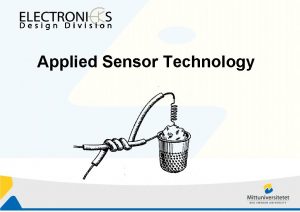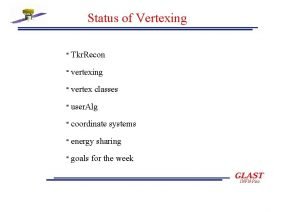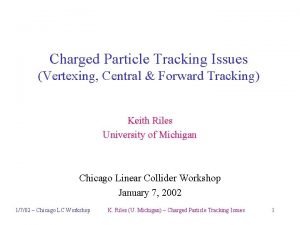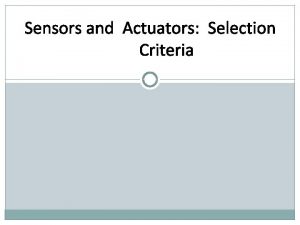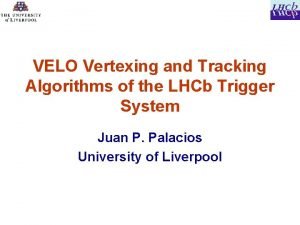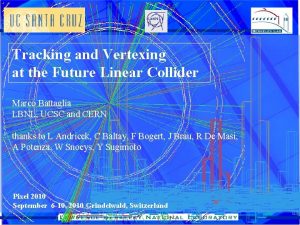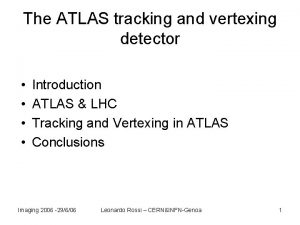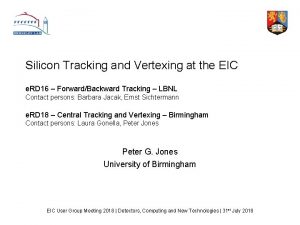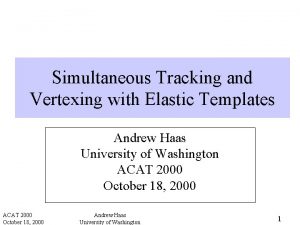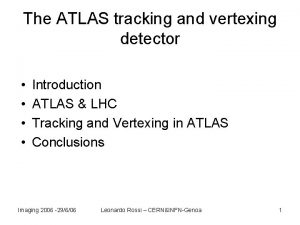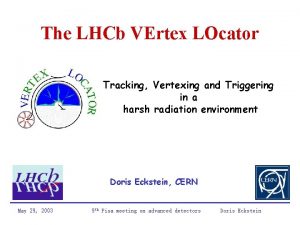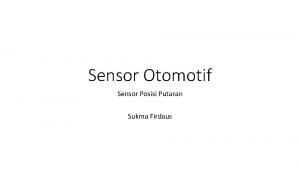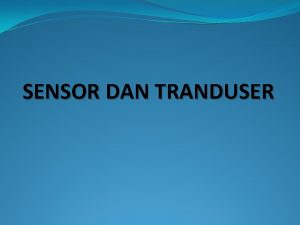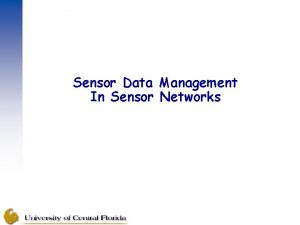Novel sensor technologies for tracking and vertexing A





















- Slides: 21

Novel sensor technologies for tracking and vertexing: A 2 D position sensitive microstrip sensor with charge division. A segmented p-type sensor with low-gain charge amplification. Esteban Currás Instituto de Física de Cantabria(CSIC-UC)

Outline Motivations for the R&D. — A 2 D position sensitive microstrip sensor. — _ _ _ — Segmented p-type sensors with low-gain charge amplification _ _ — Laser characterization Electrical equivalent circuit simulations Test beam results TCAD simulations of the device. Laser characterization of diodes with amplification. Conclusions E. Currás - LC Workshop 27 -31 May 2013, DESY 2

R&D Motivation — Charge division in microstrips: _ _ _ — Long microstrips ladders (several tens of centimeters) proposed for the ILC tracking detectors. Getting the particle hit coordinate along the strip using the charge division method. Avoid the complexity of double sided sensors and the additional material of a second layer of sensors. Low gain segmented p-type pixels (strips) _ _ Implementing a small gain in the segmented diode so we can reduce thickness of the sensors without reducing the signal amplitude Smaller contribution to the material budget. E. Currás - LC Workshop 27 -31 May 2013, DESY 3

Charge Division in u. Strips S 1 Simple single-side AC-coupled microstrip detectors with resistive coupling electrodes. X-coordinate: cluster-finding algorithms for strip detectors. Y-coordinate: Resistive charge division method. x Resistive material Aluminium y ** Electrode resistance >> preamplifier impedance. L S 1=f(y) S 2=f(L-y) y A 2 = L A 1+A 2 Resistive material: high doped polysilicon S 2 ** V. Radeka, IEEE Transaction on Nuclear Science NS-21 (1974) 51 E. Currás - LC Workshop 27 -31 May 2013, DESY 4

Proof-of-Concept Prototype 2 Beetle chips ALIBAVA DAQ system for microstrip detectors, based on the Beetle analogue readout ASIC 3 D axis stage with displacement accuracy ≈ 10 μm • 256 channels • peaking time = 25 ns • S/N≈20 for standard no irradiated detectors Pulsed DFB laser λ=1060 nm • Gaussian beam spot width ≈ 15 μm • pulse duration 2 ns Clean room laboratory at IFCA, Santander E. Currás - LC Workshop 27 -31 May 2013, DESY 5

Equivalent Electrical Circuit Detector (p+-on-n) model *** 80 cells 250 μm long p e- h+ Vbias • rise time 2 ns • Q~4 f. C Peaking time 25 ns (Beetle chip ALIBAVA DAQ system). E. Currás - LC Workshop 27 -31 May 2013, DESY 6

Signal Propagation – Linearity (Simulation) S 1 Particle t 1 t S 2 t 2 2 mm t y V S 2 18 mm E. Currás - LC Workshop 27 -31 May 2013, DESY 7

R/l=2. 8 Ω/μm R/l=12. 2 Ω/μm 20000 events ∀ measurement Systematic error => Ballistic deficit E. Currás - LC Workshop 27 -31 May 2013, DESY 8

Longitudinal spatial resolution for 6 MIPs signal A 2 A 1+A 2 1. 1% L => 220 μm 1. 2% L => 240 μm R/l=2. 8 Ω/μm σA 1=1. 83 ADU R/l=12. 2 Ω/μm σA 2=1. 80 ADU E. Currás - LC Workshop 27 -31 May 2013, DESY 9

Test Beam Characterization • Test beam at CERN SPS Pion Beam, Nov 2012 • First successful integration and synchronization with AIDA MIMOSA pixel telescope • Prelimirary results: • Monitoring of beam profile. • Currently in progress: • Efficiency and resolution using tracking information. E. Currás - LC Workshop 27 -31 May 2013, DESY 10

s/n test beam vs s/n radioctive source Resistive strips detector Conventional strips detector E. Currás - LC Workshop 27 -31 May 2013, DESY 11

SEGMENTED P-TYPE SENSORS WITH CHARGE AMPLIFICATION E. Currás - LC Workshop 27 -31 May 2013, DESY 12

Charge Multiplication- pixel detectors We are starting the fabrication of new p-type pixel detectors with enhanced multiplication effect in the ntype electrodes, very low collection times and with no cross-talk. Three different approaches: 1. Thin p-type epitaxyal substrates 2. Low gain avalanche detectors 3. 3 D with enhanced electric field. Two projects funded by CERN RD 50 collaboration to work on these technologies. http: //rd 50. web. cern. ch/rd 50/ E. Currás - LC Workshop 27 -31 May 2013, DESY 13

Low gain avalanche detectors (LGAD) Implating an n++/p+/p- junction along the centre of the electrodes. Under reverse bias conditions, a high electric field region is created at this localised region, which can lead to a multiplication mechanism (impact Ionization). Advantages = Thinning while keeping same S/N as standard detectors. High Electric Field region leading to multiplication N+ 285 um P P. Fernandez et al, “Simulation of new p-type strip detectors with trench to enhance the charge multiplication effect in the n-type electrodes” , Nuclear Instrumentsand. Methodsin. Physics. Research. A 658(2011) 98– 102. E. Currás - LC Workshop 27 -31 May 2013, DESY 14

Simulation of the Electric Field - To obtain the manufacture parameters (doping profiles) Standard Strip with P-type diffusion: 2 D and 1 D doping profiles E. Currás - LC Workshop 27 -31 May 2013, DESY 15

Red laser TCT characterization Bottom injection Standard diode n on p P-type diffusion diode 5 ns e- h+ 285 um Red laser (1060 nm) E. Currás - LC Workshop 27 -31 May 2013, DESY 16

Red laser TCT characterization Standard diode Charge collection efficiency P-type diffusion diode E. Currás - LC Workshop 27 -31 May 2013, DESY 17

Mask set (planar) AC 1 Strip = 24 Metal = 20 AC 2 Strip = 24 Metal = 24 AC 3 Strip = 24 Metal = 28 DC Strip = 32 Metal = 40 AC 4 Strip = 48 Metal = 44 AC 5 Strip = 48 Metal = 48 AC 6 Strip = 48 Metal = 52 AC Strip = 32 Metal = 40 DC Strip = 32 Metal = 40 AC 7 Strip = 62 Metal = 58 AC 8 Strip = 62 Metal = 62 AC 9 Strip = 62 Metal = 66 AC Strip = 32 Metal = 40 FEI 4 With Guard rings FEI 3 With Guard rings FEI 4 With one Guard ring CMS pixel detectors FEI 4 With one Guard ring FEI 3 With Guard rings E. Currás - LC Workshop 27 -31 May 2013, DESY 18

Summary — — — A novel 2 D position-sensitive semiconductor detector concept based on the resistive charge-division readout method has been introduced. The initial results demonstrates the feasibility of the charge division method in a fully fledged microstrip sensor. Test-beam studies on detection of minimum ionizing particles are in progress The effect of charge multiplication has been observed within RD 50 and it was started to be investigated systematically. New detector designs aim to fabricate detectors with moderate gain and fast collection times. E. Currás - LC Workshop 27 -31 May 2013, DESY 19

E. Currás - LC Workshop 27 -31 May 2013, DESY 20

E. Currás - LC Workshop 27 -31 May 2013, DESY 21
 Rob ratterman
Rob ratterman Applied sensor technologies
Applied sensor technologies Savex technologies tracking
Savex technologies tracking Fspos vägledning för kontinuitetshantering
Fspos vägledning för kontinuitetshantering Novell typiska drag
Novell typiska drag Tack för att ni lyssnade bild
Tack för att ni lyssnade bild Ekologiskt fotavtryck
Ekologiskt fotavtryck Varför kallas perioden 1918-1939 för mellankrigstiden?
Varför kallas perioden 1918-1939 för mellankrigstiden? En lathund för arbete med kontinuitetshantering
En lathund för arbete med kontinuitetshantering Adressändring ideell förening
Adressändring ideell förening Personlig tidbok
Personlig tidbok Anatomi organ reproduksi
Anatomi organ reproduksi Förklara densitet för barn
Förklara densitet för barn Datorkunskap för nybörjare
Datorkunskap för nybörjare Stig kerman
Stig kerman Debattinlägg mall
Debattinlägg mall För och nackdelar med firo
För och nackdelar med firo Nyckelkompetenser för livslångt lärande
Nyckelkompetenser för livslångt lärande Påbyggnader för flakfordon
Påbyggnader för flakfordon Lufttryck formel
Lufttryck formel Offentlig förvaltning
Offentlig förvaltning Jag har nigit för nymånens skära text
Jag har nigit för nymånens skära text

